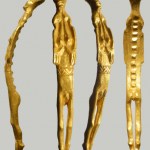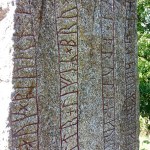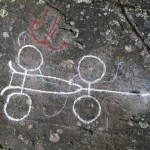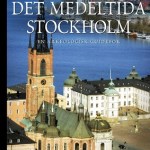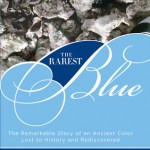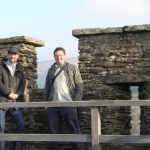archaeology
I have a problem with the term Viking Age. And it's not likely that I will ever get satisfaction. Because I am a Scandy archaeologist, and the term is owned by UK historians and the general English-speaking public.
The three-ages system was established by C.J. Thomsen in his 1821 book Ledetraad. It divides Scandinavian Prehistory into three ages, characterised by the material used in cutting tools: first stone, then bronze, then iron. In Swedish, this taxonomical level is the ålder – stenåldern, bronsåldern, järnåldern – using the close cognate of what Snorri back in the 13th century called…
Come September I'm scheduled to fulfil a major life goal of mine after over 15 years of impatient waiting. I'm going to teach Scandy Archaeology 101 for the first time, at the University of Umeå!*
The fall semester is divided into four modules of which I am head teacher for three: 1) Introduction, 2) Stone Age & Early Bronze Age, 4) Landscape & paleoecological methods. I'm going to use this blog entry as my draft notes for the introductory module, and I'd like to ask you, Dear Reader to help me improve them with comments, suggestions and questions. Let's make a list of the most…
My Wulfheodenas homie David Huggins asked me a good question. ”Shield maidens! True or False? Okay, that was a bit general, but female 'warrior' graves, symbolic or otherwise?”. I take this to mean “Were there female warriors in Northern Europe AD 500-1000?”
Let's start by examining why everyone accepts that there were male warriors. Indeed, to my knowledge most scholars believe that at least, say, 99.9% of all warriors were men, and conversely that a considerable percentage of free-born men received some degree of weapons training. There are two main reasons for this.
Firstly, the written…
This is a site in the vicinity of Meroe in the Sudan, and seem to date to a period of transition between foraging and farming. From The Telegraph:
In a graveyard in Al-Kadada, north of Khartoum, the archaeologists have dug up the tomb of a man and a woman facing each other in a ditch, with bodies of two women, two goats and a dog buried nearby.
The discovery of the group "confirms" excavations last year which found traces of the oldest human sacrifice ever identified in Africa, Jacques Reinold, a researcher for the French section of the Sudanese antiquities department, said.
What do you…
Smørenge is one of the sites on Bornholm that keeps yielding mid-1st-millennium gold mini-figurines. But in addition to the 2D representations on embossed gold foil known as guldgubber, an artisan employed by the magnate family at Smørenge also made nude 3D figurines. The fifth of these was found by one of the island's famously skilful metal detectorists in May, and she's quite a revelation. Because representations of women are far less common than of men in Iron Age art, and nude women are almost unknown.
The Smørenge woman is wearing only a hatched belt. She has the prominent "seer's thumbs…
The Stone of Sälna is a runestone (U 323) erected about AD 1000 at Sälna hamlet where a major road crossed Hargsån stream in Skånela parish, Uppland. (This is not far from where Arlanda airport now sprawls.) None of this is unusual. But the stone's great height, its inscription and its later fate are. Here's what can be made out of the runes as they survive today and as documented by a 17th century antiquarian.Østeinn and Jorundr and Bjorn, the brothers, erected [this] stone [after] ...steinn drums, their father. God help his spirit and soul, forgive him his crimes and sins. Forever shall…
Contract archaeology is the current term for what used to be called rescue archaeology: documenting archaeological sites slated for destruction through land development. (Swedes sometimes fall for a false friend and translate an old word of ours, exploateringsarkeologi, into “exploitation archaeology”, suggesting fieldwork undertaken by people in pimp/ho outfits to the soundtrack from Shaft.)
Swedish contract archaeology has seen steady growth measured decade by decade since the end of WW2, both in terms of the number of active field archaeologists and of the number of units. I seem to…
On 10 June I blogged about some grisly finds from Cliffs End in Kent which to my mind indicate eight centuries of human sacrifice during the Late Bronze and Iron Ages. I invited colleagues at Wessex Archaeology who did the dig to comment, and Chief Osteoarcheologist Jacqueline McKinley kindly sent me some detailed views.
The first thing to note is that though the full monograph hasn't appeared yet and my blog entry was based on a pop-sci feature in British Archaeology, a scholarly paper on the site has in fact been published:McKinley, Schuster, & Millard 2013. Dead-sea connections: a…
Bronze Age rock art along Sweden's south-east coast is rich but not as varied as that of the famous west-coast region. One motif that we have been missing is the four-wheel wagon. It isn't common anywhere except on one site, Frännarp in inland Scania (below right), but we have had none whatsoever where I am.
Wagons at Frännarp in Scania
The other day we got our first wagon: at the rich classical site of Himmelstalund on the outskirts of Norrköping in Östergötland province. According to period convention, it is depicted in a flattened perspective with the wheels seen from the sides and the…
Despite loud (and in my opinion, well argued) opposition to the Swedish restrictions on metal detector use by honest amateurs, our authorities are sadly not coming round to anything resembling the Danish legislation that works so well.
My friend and fieldwork collaborator Tobias Bondeson is a skilled amateur detectorist who regularly publishes scholarly papers on his finds. He pointed me to the latest developments in Swedish officialdom on the topic, a 26 March proposition from the Ministry for Culture to Parliament: Kulturmiljöns mångfald, ”The Diversity of the Historic Environment”. Tobias…
British Archaeology #131 (July/August) has a feature by Pippa Bradley that caught my interest. It's about a Wessex Archaeology dig in 2004-05 at Cliffs End farm in Thanet, a piece of north-east Kent that was an island up until the 16th century when silting finished connecting it to mainland England. What we're dealing with here is ritual murder, some pretty strange disposal of the dead and ancient Scandinavian migrants.
Use of the site begins in earnest with six ring-ditch barrows during the Early Bronze Age (2200-1500 cal BC). These were poorly preserved and yielded few interesting finds.…
Historiska media is a publishing house in Lund. In recent years they have been putting out pop-sci guide books about Medieval Sweden, province by province. I've reviewed the volumes about Södermanland and Uppland provinces here. And now my friend and Fornvännen co-editor Elisabet Regner has written the first volume in the series that deals with a town, not a province: about Stockholm, in whose suburbs I've lived for almost all my life. Together with the Uppland and Södermanland volumes, Det medeltida Stockholm gives us Stockholmers a pretty good grip on our Medieval surroundings.
I shouldn't…
“First, we’re going to collect our data,” Jack, the archaeologist, was telling me as we slogged down the narrow overgrown path. He seemed annoyed. “Then, we’ll leave. Until we leave, they won’t leave. They think it would be rude. After they leave, we’ll go back and map in the abandoned camp.”
I had just arrived at the research camp in the Ituri Forest, then Zaire and now the Congo, after a rather long and harrowing journey that took me from Boston to New York to London to Lagos to Kinshasa to Kisingani to Isiro, all by plane, then over 250 kilometers of increasingly less road-like road, to…
Current World Archaeology #58 (April/May) has a seven-page feature on the 8th century mass graves in ships at Salme on Saaremaa in Estonia. This astonishing find interests me greatly as the ships and the dead men's equipment are Scandinavian, and so I mentioned it here back in 2008. One of the sword pommels is an example of the animal-figurine weaponry Jan Peder Lamm and myself have published on and suggest Finnish involvement. And boat burial in and of itself is a theme with which I have worked a lot. Here we seem to be dealing with Scandies who got badly beaten when attempting a raid, and…
A few years ago I did some fieldwork at Djurhamn, a peripheral naval harbour of the 15th through the 17th centuries (and blogged much about it: A - B - C - D - E - F - G - H, and published a paper on it in an anthology). Now maritime archaeologist Jonas Wiklund has published a paper on the sad fate of the Rikswasa, a nearby shipwreck that was salvaged by a diving firm and made into coffee-table ornaments in the 1960s with permission from the National Maritime Museum. Jonas has kindly allowed me to make his paper (in Swedish) available here on Aard.
Wiklund, J. 2013. Rikswasa -- från…
Apparently, the women have jugs.
No, seriously. In a certain archaeological culture known from the vicinity of Prague, male and female burials are distinguished by the mode of burial and the artifacts. The males tend to be buried with their heads towards the west and along with various weapons. Females, on the other hand, tend to be buried with their heads towards the east and surrounded by domestic jugs.
This is interesting for many reasons (to an archaeologist, at least) but even more interesting is the possible discovery of a transgendered person's burial. This is a male skelton…
In this well-written, painstakingly annotated and beautifully designed book, physicist Baruch Sterman (with contributor Judy Taubes Sterman) traces the history and prehistory of a certain blue pigment, along with its cultural and religious significance through the ages. It's what the Torah and Talmud calls tekhelet, and it's made from a gland harvested from Murex sea snails.
Though greatly interested in history, archaeology and biology, I find myself poorly equipped to engage with the book's subject matter. Or put differently, I don't think I'm part of its intended audience. Because there's a…
After only one day of my teaching, one of my Kalmar students has already twigged that there's a funny discrepancy between the course's post-modernist meta-archaeological syllabus and the opinions voiced by his main teacher from the lectern and elsewhere. Fearlessly he goes for my jugular on the course blog, where all the students have to post in order to pass the course, and I respond.
In my career (such as it is), I keep running into a hurdle having to do with the great value placed in the arts/humanities on the novelty of interpretations. Time and again, reviewers will say that my work tackles interesting questions in a methodologically competent manner using solid data – but that my interpretations (humanities people aren't comfortable with calling them “results”) aren't novel enough.
This makes no sense to me. I don't aim to produce a new interpretation. Nor do I wish to retain an old one. I just want to find the most-likely-to-be-correct answer to the question, given…
Here's a guest entry from my friend Professor Howard Williams of the University of Chester. He was my charming guide on an antiquarian road trip Sunday.
I met Martin at his luxurious guest accommodation on the main campus of the University of Chester and we got into my trusty VW. We left Chester, heading around the historic city and out on the Wrexham Road over the 18th-century Grosvenor Bridge over the River Dee and into Wales. Driving along the A55 along the spine of Flintshire, we stopped near Whitford to investigate two sites.
First, we visited the 3.4m-high early medieval cross-slab at…


